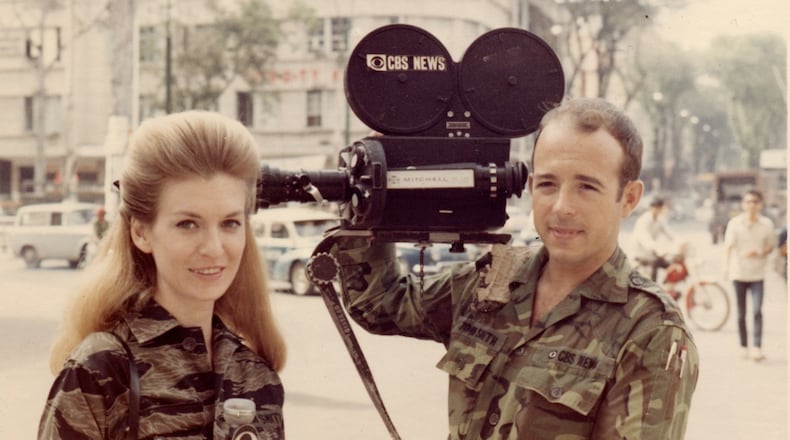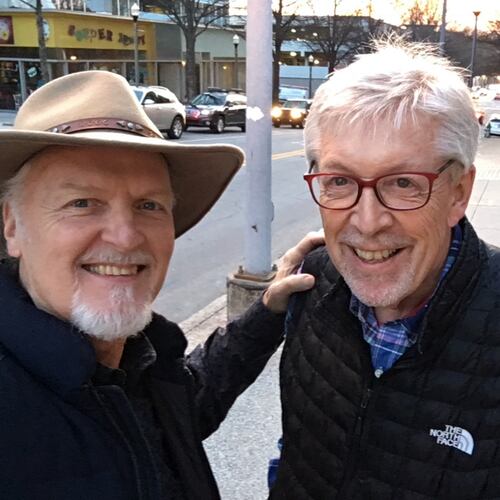Before graduating high school in the late 1950s John Smith was breaking news stories and providing photographs for Nashville newspapers and television stations.
His first love was the 4x5 Speed Graphic camera with a strobe flash made famous by his hero, New York City press photographer Arthur “Weegee” Fellig, known for his telling black-and-white images.
Smith later moved to film and video, spending much of his career as a CBS cameraman, his wife Jan estimating that he shot in over 100 countries, including covering multiple wars and era-defining events such as the Tiananmen Square protests.
John Smith, 80, died unexpectedly of a heart attack on Jan. 29 at his home in Nashville, where he and Jan had lived since his 2017 retirement from WSB-TV. He worked for the Atlanta station the last 22 years of his career. A private “Celebration of Life” was held Feb. 8 in Nashville.
His many jobs at the Atlanta TV station included organizing reporting crews, tracking their whereabouts, the stories they were working and plotting how they would fit into the station’s daily newscasts.
“He did the work of several people,” said Mark Winne, a WSB-TV reporter for 34 years. “He was extremely calm under pressure, almost serene. He never lost his cool. But then again, this was a man who at one time had done his job with bullets flying around him.”
Which is putting it mildly. At CBS he covered conflicts in Nicaragua and Guatemala, and, during the 1980s, the Salvadoran Civil War. But famously, off and on from 1965 to 1975, he toiled in the marshes, jungles and rice paddies of Vietnam.
His son Cannon Smith points out that “huge amount of the footage” appearing in Ken Burn’s 2017 television documentary, “The Vietnam War,” was shot by John.
Jan Smith, who usually accompanied her husband, recalled, “We always stayed at the Caravelle Hotel [in Saigon, now Ho Chi Minh City], next to CBS’s bureau.”
She remembers at one time waving from a balcony at soldiers called out to fight in the Tet Offensive.
"That night many of them came back in body bags stacked in the back of trucks," she said.
Remarkably, John Smith had only one known close call, he was wounded by shrapnel while filming a Viet Cong mortar attack outside Da Nang. He was air lifted to Hong Kong after his Vietnamese hospital was bombed.
But after Vietnam, he survived two airplane crashes, in Central America and North America. He also walked away from two helicopter crashes and a Boeing 707 emergency landing in Brazil on a press plane covering President Reagan.
Still, the most ravaging toll on his body came from the day-to-day carting of a ponderous camera and equipment all over the world for nearly 30 years. Cannon Smith, himself a news cameraman for 27 years, said John had numerous surgeries on his back, shoulder, knees and elbows.
He was born May 5, 1939, in east Nashville, and at Litton High he joined the yearbook staff and camera club. Smith outgrew those adolescent associations and, mimicking his idol Weegee, began staying up half the night chasing ambulances, fire trucks and police cars for local news outlets.
Many times he took along childhood pal Billy Hoover, who recalls getting phoned many times at 1 a.m. or later to photograph one disaster or another. Memorably, he and Smith were first on the scene when Nashville’s Hattie Cotton Elementary school was bombed in 1957, one day after admitting its first black student. The explosion crumbled walls and blew out every window causing $71,000 in damage. To this day no one has been charged.
“He was driven to break a story, no matter where or when,” Hoover said. “At one time he had seven individual radios, including two two-way police scanners. There are 93 counties in Tennessee, not counting a couple, and he knew the voices of every county police dispatcher, so he knew where to go simply by hearing the tone of voice. He actually had a mobile phone in his car, where the transmitter was in the trunk, and the part you held was big as brick.”
Smith was hired out of high school by the local CBS affiliate, eventually getting promoted to the national desk where he received the first of many Vietnam assignments.
Both in Vietnam and for years after, he worked alongside broadcasting legends like Walter Cronkite, Dan Rather and longtime CBS correspondent Bert Quint. Quint covered so many wars and conflicts during his quarter century with the network that he was known as “The Fireman.”
He first met Smith in August 1967, and one of their first collaborations was in the Demilitarized Zone (between North and South Vietnam) lying in a bunker beneath a night sky fully lit with rockets and shells. He remembers that all they had to eat was raisins Smith had and, occasionally, “these large Vietnamese bugs” that carried off dropped raisins. “We always heard,” Quint said, “those bugs had a lot of protein.
“The success I had as a correspondent,” Quint said recently, “was due more to the camera team than to my own skills. The best camera people like John had an instinct, not just for a story idea but a survival instinct. They knew how to get in and when to get out."
“There were frustrations and failures,” he added. “I remember John and I getting on a two-seater plane and flying into North Vietnam we did, I counted them, 14 gut wrenching bomber dives. I know John got some incredible stuff, but when we got back to the bureau we couldn’t use any of the footage. [The film] had somehow been damaged or scratched.”
Smith’s globe hopping continued for nearly two decades post Vietnam, his itinerary a virtual scrapbook of late 20th century world history.
He went to China with President Gerald Ford, and covered Jimmy Carter’s 1976 presidential run. He was with Rather on his exclusive interview in Bagdad with Saddam Hussein, and he was in Egypt when Anwar Sadat was assassinated. He was in China for the Tiananmen Square Protests; he covered dozens of space launches and the royal wedding of Charles and Diana. He occasionally shot for “60 Minutes,” and Cannon Smith remembers as a child getting carried around on the shoulders of famed correspondent Ed Bradley.
Smith was let go in the early 1990s as CBS shed veteran correspondents, producers and camera teams. He started at WSB-TV in 1995, but his official position in the engineering, news gathering department barely describes his contributions.
Smith helped create WSB-TV’s current archival system. He also played a critical role a decade ago when the station transitioned from tape to digital, which was only fitting for man who began his career using the oversized Speed Graphic press camera.
“He was very proud of his career,” friend and news editor Kisha Brown said, “but he was very humble, very quiet. You really had to pry stories out of him. For some in the newsroom he could be intimidating. But once you got to know him he was really loveable, the kind of guy who loves talking about his cats and dog.”
Childhood friend Hoover agrees with this depiction, though he wishes Smith had shown a tad less humility.
“Just a few weeks ago I was texting him to compile a book,” Hoover said. “I’ve actually been on him to do it for several years. I personally have a lot of his darkroom equipment and negatives going back to the fifties.
“But he wasn’t ever going to do it,” Hoover concluded. “He was driven, a go-getter like none other. But I don’t think he ever thought he was helping preserve history. The way he thought, writing a book would be bragging or, worse, even a kind of arrogant.”
Smith is survived by his wife Jan Smith and their son Cannon Smith, along with daughters Stacye Smith, Margery Smith, Stephanie Smith and son Eric Smith.
About the Author
Keep Reading
The Latest
Featured

